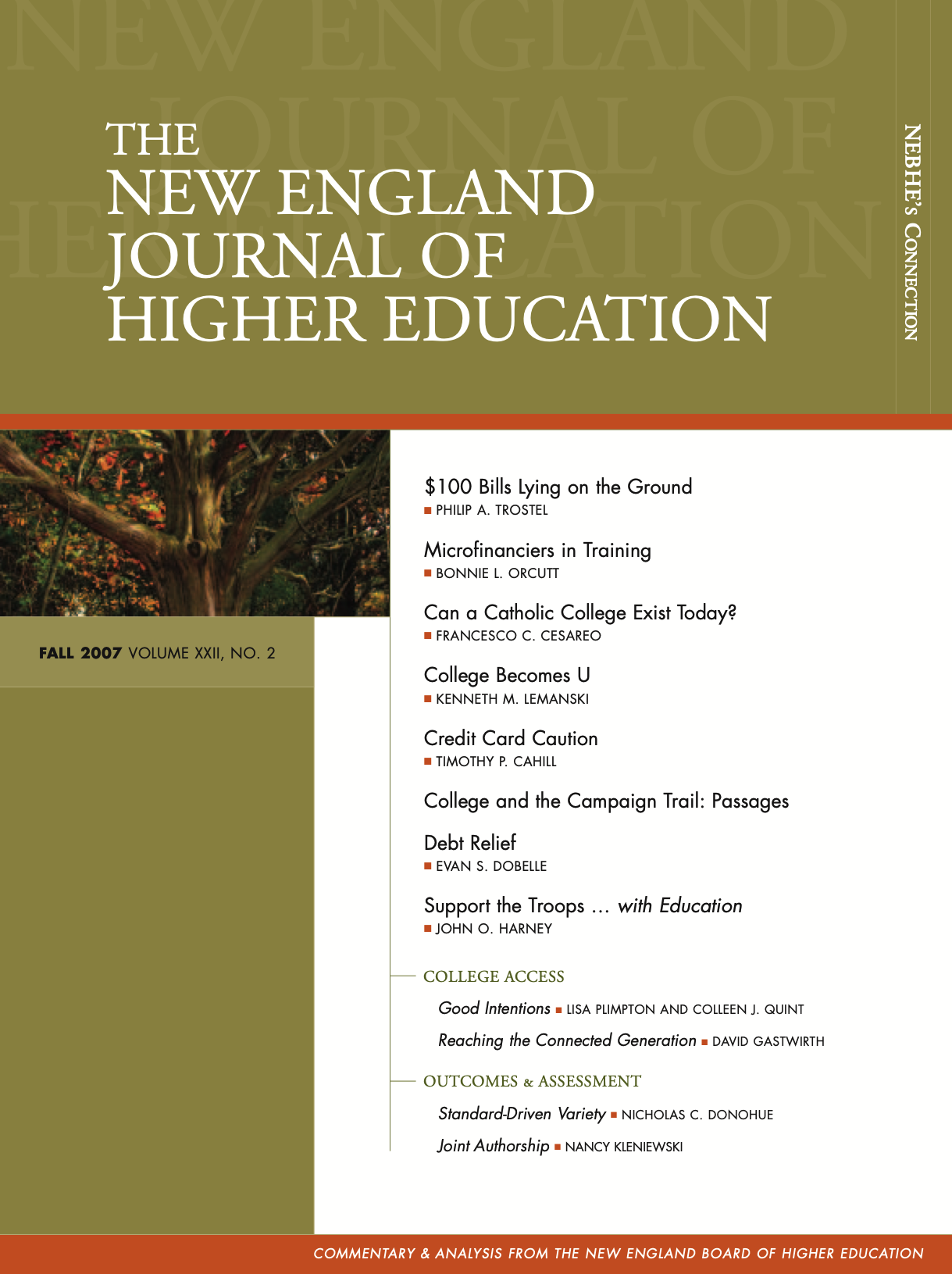
Click the cover image to view and download this issue in PDF format.
BOSTON—The new Fall 2007 issue of The New England Journal of Higher Education features expert commentaries quantifying the return on public investment in higher education, exploring a central Massachusetts program in which college students support micro-enterprises in Worcester and Nicaragua and examining other key issues.
For more than 20 years, the New England Board of Higher Education’s journal on higher education and economic issues was known as Connection. This past summer, NEBHE “re-branded” the quarterly as The New England Journal of Higher Education.
The Fall 2007 issue of the journal features the following articles:
$100 Bills Lying on the Ground • University of Maine economist Philip A. Trostel explains that public investment in higher education pays for itself 7.5 times over in additional tax revenues and reduced social welfare spending. But while states make most of the investment, Washington gets most of the return.
Microfinanciers in Training • Worcester State College economist Bonnie L. Orcutt describes a novel program that teaches students to be finance innovators while alleviating poverty in Nicaragua and at home.
Can a Catholic College Exist Today? • Assumption College President Francesco C. Cesareo explores the challenge of maintaining religious identity on campuses marked by pluralism.
College Becomes U • Massachusetts State Colleges executive officer Kenneth M. Lemanski explains why Massachusetts state colleges want to become state universities.
Credit Card Caution • In a follow-up to the journal’s earlier coverage of colleges “pushing plastic,” Massachusetts state Treasurer Timothy P. Cahill examines ways colleges can help protect naïve students from the hidden fees and tricky lending practices of credit card companies.
Good Intentions • The number of Maine high school graduates who intend to enroll in college after high school has increased, but actual enrollment has not. Lisa Plimpton and Colleen J. Quint of Maine’s Mitchell Institute explain why.
Reaching the Connected Generation • Viral marketing … buzz marketing… product seeding … Duke University researcher David Gastwirth looks at ways that “college access marketers” are beginning to speak the language of their audience.
Standard-Driven Variety • Nellie Mae Education Foundation President Nicholas C. Donohue explains how alarming workforce projections, the explosion of online coursework and ever-increasing skill demands in technical trades may all force acceptance of a greater variety of educational outcomes.
Joint Authorship • Bridgewater State College Provost Nancy Kleniewski describes how six Massachusetts campuses set out to measure writing competence—and found one another.
Debt Relief • NEBHE President Evan S. Dobelle calls for “fairness and transparency” in college financing, especially the student loan system. “New England’s leaders of education, government and business are working to help students overcome the obstacles of a class-based system of college access,” writes Dobelle. “Improving college readiness and preparation only to have less-advantaged students locked outside the college gates by the specter of unacceptably high debt is both cruel and economically self-destructive.
Behind the News: Tough Challenges • NEBHE Chair and former four-term Maine state Sen. Mary R. Cathcart outlines challenges that New England’s opinion leaders should be thinking about. Among them: serving the underserved, preparing nurses, enlisting employers to help pay for workers’ education, building on New England’s strengths in environmental design and sustainability and expanding broadband and cell phone coverage to all New Englanders.
Editor’s Memo • Though one of the U.S. military’s key recruiting tools is the promise of helping to pay for college, most New England GIs and veterans returning from Iraq and Afghanistan don’t know what education benefits their service and sacrifice entitle them to, and the government offers little guidance, according to Executive Editor John O. Harney. Harney explains how a community college is stepping up where others have fallen down.
[ssba]
